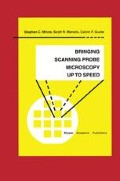Abstract
The role of the scanning probes for digital storage has yet to be defined, but we can discuss some significant steps that have been taken in this field. We will describe the work on writing bits on magnetic media, although there are other strategies for storing data with scanning probes. Mamin2 has worked out a system where he creates small indents in PMMA for storing a single bit. Barrett3 has employed the probe to store and read bits as trapped charge in films of silicon nitride. At Canon, Takimoto4 has used the STM to store bits by changing the conductivity of the medium with a current pulse on the tip. Hosoka5 has used small gold clusters deposited by field desorption from the probe tip.
Access this chapter
Tax calculation will be finalised at checkout
Purchases are for personal use only
Preview
Unable to display preview. Download preview PDF.
Reference
Part of this chapter is reprinted with permission from Manalis et al., “Submicron studies of recording media using thin-film magnetic scanning probes,” Applied Physics Letters 66, 2585–2587 (1995). Copyright 1995 American Institute of Physics.
H.J. Mamin and D. Rugar, “Thermomechanical writing with an atomic force microscope tip,” Appl, Phys. Lett. 61, 1003–1005 (1992)
R.C. Barrett and C.F. Quate, “Charge storage in a nitride-oxide-silicon medium by scanning capacitance microscopy,” J. Appl, Phys. 70, 2725–2733 (1991)
K. Takimoto, H. Kawade, E. Kishi, K. Yano, K. Sakai, K. Hatanaka, K. Eguchi, and T. Nakagiri, “Switching and memory phenomena in Langmuir-Blodgett films with scanning tunneling microscope,” Appl, Phys. Lett. 61, 3032–3034 (1992)
S.Hosaka, A. Kikukura, H. Koyanagi, T. Shintani, M. Miyamoto, K. Nakamura, and K. Etoh,SPM-based data storage for ultrahigh density recording Nanotechnology 8, A58–A62 (1997).
P. Grütter, H.J. Mamin, and D. Rugar, Scanning Probe Microscopy II (1991); P. Grütter, MSA Bulletin 24, 416 (1994)
D. Rugar, H.J. Mamin, P. Guethner, S.E. Lambert, J.E. Stern, I. McFadyen, and T. Yogi, J. Appl. Phys. 68, 1169 (1990)
J. Moreland and P. Price, Appl. Phys. Lett. 57, 310–312 (1990)
T. Ohkubo, J. Kishigami, K. Yanagisawa, and R. Kaneko, IEEE Transactions on Magnetics 6, 5286 (1991); and IEEE Trans. J. on Mag. in Jap., 8, 245 (1993)
T. Goddenhenrich, U. Hartmann, and C. Heiden, Ultramicroscopy 42, 256 (1992)
K. Babcock, M. Dugas, V. Elings, and S. Loper, IEEE Transactions on Magnetics, to appear.
P. Bryant, S. Schultz, and D.R. Fredkin, J. Appl. Phys. 69, 5877 (1991)
C.-J. Lin, J.C. Suits, and R.H. Geiss, Appl. Phys. 63, 3825 (1988)
M. Mansipur, R. Giles, and G. Patterson, J. Appl. Phys. 69, 4844 (1991)
K.O–Grady, T. Thomson, J.J. Greaves, and G. Bayreuther, J. Appl. Phys. 75, 6849 (1994)
MultiMode, TappingMode, and LiftMode are trademarks of Digital Instruments. TappingMode and LiftMode, V. Elings and J. Gurley, U.S. Patent Nos. 5,266, 801 and 5,308,974, Digital Instruments, Santa Barbara, CA.
Measured via vibrating sample magnetometry; 3M Center, St. Paul, MN.
Measured via polar Kerr effect; Censtor Corp2, San Jose, CA. This technique averages the response of the surface layer over an area ~1 mm.
This is consistent with previous work (Ref. 6) which found a 15% variation in imaging sensitivity between tips.
H.-P.D. Shieh and M.H. Kryder, IEEE Trans. Mag. 24, 2464 (1988).
Author information
Authors and Affiliations
Rights and permissions
Copyright information
© 1999 Springer Science+Business Media New York
About this chapter
Cite this chapter
Minne, S.C., Manalis, S.R., Quate, C.F. (1999). Scanning Probes for Information Storage and Retrieval. In: Bringing Scanning Probe Microscopy up to Speed. Microsystems, vol 3. Springer, Boston, MA. https://doi.org/10.1007/978-1-4615-5167-6_7
Download citation
DOI: https://doi.org/10.1007/978-1-4615-5167-6_7
Publisher Name: Springer, Boston, MA
Print ISBN: 978-1-4613-7353-7
Online ISBN: 978-1-4615-5167-6
eBook Packages: Springer Book Archive

